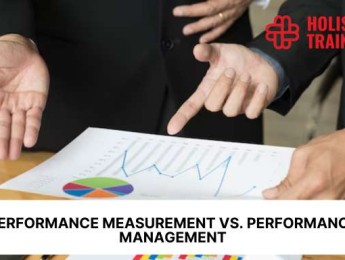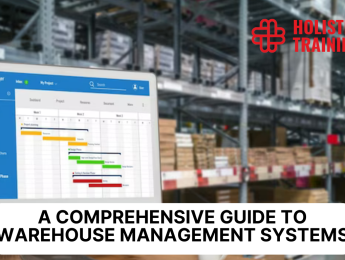- Table of Contents
- Introduction
- What Is Performance Measurement?
- The Role of Performance Measurement in Organisations
- Performance Measurement & Other Evaluation Techniques
- What Is Performance Management?
- KPIs vs. OKRs
- Achieving Performance Management After Performance Measurement
- Key Differences Between Performance Measurement and Performance Management
- Performance Management System & Performance Measurement System: Which One Do You Really Need?
- In Conclusion
Introduction
Performance in any organisational setting is paramount. It is the life force that drives companies toward their goals, fuels growth, and ensures sustainability. However, achieving optimal performance involves a sophisticated interplay of various factors, strategies, and tools. In this intricate web of performance enhancement, two fundamental concepts emerge—Performance Measurement and Performance Management. While often used interchangeably, these terms have distinct roles and impacts on an organisation's journey toward success. In this comprehensive exploration, we delve deep into the realms of Performance Measurement and Performance Management, unravelling their nuances and understanding their vital roles in the corporate world.
What Is Performance Measurement?
Performance Measurement is the systematic process of quantifying and tracking an organisation's performance against predetermined goals and objectives. It involves the collection, analysis, and interpretation of data to evaluate various aspects of an organisation's performance, such as efficiency, effectiveness, productivity, and quality. Performance Measurement provides a snapshot of the organisation's current status, highlighting both strengths and areas that require improvement.
The Role of Performance Measurement in Organisations
Performance Measurement is akin to a powerful magnifying glass, allowing organisations to scrutinise their operations, strategies, and outcomes in meticulous detail. Its multifaceted benefits make it a cornerstone of informed decision-making and continuous improvement within any organisational structure. Here’s how it helps organisations:
1. Identifying Strengths and Weaknesses
At its core, Performance Measurement is about data – raw, unfiltered information that speaks volumes about an organisation's functioning. By meticulously collecting and analysing data, companies gain insights into their strengths, pinpointing areas where they excel. Simultaneously, it sheds light on weaknesses, identifying bottlenecks, inefficiencies, or underperforming departments. This understanding is fundamental, offering a clear roadmap for strategic improvements.
2. Facilitating Informed Decision-Making
In the fast-paced world of business, decisions need to be swift and well-informed. Performance Measurement provides the necessary metrics and analysis, transforming intuition-based decisions into data-driven strategies. Whether it's expanding product lines, entering new markets, or optimising supply chains, the data obtained through Performance Measurement acts as a compass, guiding leaders toward choices that are more likely to yield positive outcomes.
3. Resource Optimisation
Resources, be it financial, human, or technological, are finite and valuable. Performance Measurement helps organisations allocate these resources judiciously. By identifying processes or departments that are particularly efficient, resources can be directed where they're needed the most. Conversely, if certain areas are consistently underperforming, appropriate measures can be taken, such as investing in staff training, process redesign, or adopting new technologies.
4. Enhancing Accountability and Transparency
Transparent communication is vital within any organisation. Performance Measurement creates a culture of accountability where employees are aware of their roles in achieving organisational goals. When objectives are measurable, employees understand their individual contributions in the larger context. This transparency nurtures a sense of ownership, motivation, and responsibility, fostering a positive work environment where everyone is working towards shared objectives.
5. Customer-Centric Improvements
Customers are the lifeblood of any business. Performance Measurement offers a lens through which organisations can view their products or services from the customer's perspective. Customer feedback and satisfaction metrics provide valuable data that can be analysed alongside operational performance. This integration of customer-centric data into Performance Measurement helps organisations tailor their offerings, improve customer service, and build lasting relationships, ultimately driving customer loyalty and retention.
6. Strategic Alignment
Every organisation has strategic goals that define its long-term vision. Performance Measurement ensures that day-to-day operations align with these strategic objectives. Regular assessment against key performance indicators enables organisations to track their progress toward overarching goals. If deviations occur, strategic adjustments can be made promptly, ensuring that the company stays on course and adapts proactively to market changes.
7. Benchmarking and Competitive Advantage
Understanding where your organisation stands in comparison to competitors is critical. Performance Measurement allows for benchmarking against industry standards or competitors’ performance metrics. This comparative analysis provides valuable insights, highlighting areas where the organisation outperforms competitors and areas that require improvement. Leveraging this information, organisations can gain a competitive edge by focusing on areas that directly impact their market positioning.
In essence, Performance Measurement is not just about numbers; it's about empowering organisations with the knowledge to thrive. By harnessing the insights derived from Performance Measurement, businesses can streamline operations, foster innovation, enhance customer satisfaction, and ultimately position themselves for sustained success in the ever-changing landscape of the modern business world.
Performance Measurement & Other Evaluation Techniques
Within the complex tapestry of organisational evaluation, Performance Measurement stands out as a quantitative powerhouse, but it does not operate in isolation. To truly comprehend its significance, it's essential to explore how Performance Measurement interweaves with other evaluation techniques, creating a comprehensive framework for understanding and improving organisational performance.
Performance Appraisal and Evaluation
Performance Appraisal and Evaluation are traditional methods used to assess employee performance. While Performance Measurement often includes employee-related metrics, such as productivity and efficiency, it goes beyond individual performance. Performance Measurement zooms out to evaluate entire departments, processes, and even the organisation as a whole. In contrast, Performance Appraisal and Evaluation are more focused on individual achievements and are typically conducted periodically, often annually. Performance Measurement, with its continuous data collection and analysis, provides a real-time, broader perspective that aids in strategic decision-making.
Process Evaluation
Process Evaluation delves into the efficiency and effectiveness of specific operational processes within an organisation. Performance Measurement contributes by providing quantitative data on these processes. For instance, if a manufacturing process is being evaluated, Performance Measurement can offer insights into production rates, error percentages, and resource utilisation. By integrating these metrics, Process Evaluation becomes more robust, enabling organisations to identify bottlenecks and streamline operations for maximum efficiency.
Financial Evaluation
Financial Evaluation focuses on the economic aspects of an organisation, including revenue generation, expenditure, and profitability. Performance Measurement provides critical financial data, offering insights into the cost-effectiveness of various activities. By aligning financial metrics from Performance Measurement with broader financial evaluation, organisations gain a comprehensive understanding of their financial health. This synergy aids in budget allocation, investment decisions, and long-term financial planning.
Customer Satisfaction Surveys
Customer Satisfaction Surveys are invaluable tools for understanding customer perceptions and preferences. Performance Measurement complements these surveys by providing additional quantitative data. For instance, if a customer survey indicates dissatisfaction with product quality, Performance Measurement can provide specific data on defect rates, allowing organisations to pinpoint the exact issue. By amalgamating customer feedback with quantitative performance data, organisations can create targeted strategies for enhancing customer satisfaction, leading to increased brand loyalty and positive word-of-mouth.
Stakeholder Surveys and Social Impact Assessment
Stakeholder Surveys and Social Impact Assessment are essential for gauging the wider impact of an organisation on society and its stakeholders. Performance Measurement contributes by providing quantitative indicators related to social impact, such as community outreach programmes, environmental sustainability metrics, or employee welfare initiatives. By aligning these quantitative metrics with qualitative feedback from surveys, organisations gain a comprehensive understanding of their social responsibility efforts. This holistic evaluation informs socially responsible decision-making, fostering a positive corporate image and strengthening relationships with stakeholders.
Continuous Improvement Initiatives
Continuous Improvement Initiatives, such as Six Sigma or Lean methodologies, aim to enhance processes and eliminate inefficiencies. Performance Measurement acts as the backbone of these initiatives by providing real-time data for analysis. These initiatives thrive on data-driven decision-making, and Performance Measurement ensures a constant flow of relevant, quantifiable information. By incorporating Performance Measurement metrics, organisations can identify areas for improvement, set benchmarks, and measure progress, facilitating the continuous evolution of processes and practices.
In essence, Performance Measurement does not exist in isolation but rather integrates seamlessly with various evaluation techniques. By combining quantitative data from Performance Measurement with the qualitative insights from other evaluation methods, organisations can create a rich, nuanced understanding of their operations. This comprehensive perspective equips decision-makers with the tools they need to enhance processes, optimise resources, improve customer satisfaction, and align their strategies with the ever-changing demands of the market, ensuring sustained success and growth.
What Is Performance Management?
Performance Management, on the other hand, is a holistic approach aimed at optimising organisational performance by aligning individual and departmental objectives with overall organisational goals. It is as equally important as performance measurement; in fact, statistics show that a mere 2% of businesses consider performance management unimportant. It involves setting clear objectives, continuously monitoring progress, providing feedback, and offering support to enhance performance outcomes. Performance Management is not merely about evaluating past performance; it is about shaping the future by nurturing talent, fostering innovation, and ensuring alignment with the organisation's strategic vision.
KPIs vs. OKRs
KPIs and OKRs are pivotal components of Performance Management, each serving distinct roles. KPIs are specific metrics tailored to measure particular aspects of organisational performance, such as sales figures, customer satisfaction, or employee productivity. OKRs, on the other hand, are outcome-oriented objectives that define clear goals and the key results necessary to achieve them. While KPIs focus on specific metrics, OKRs provide a strategic framework, encouraging innovation and holistic performance enhancement.
Table 1: Comparative analysis of KPIs and OKRs
Criteria | Key Performance Indicators (KPIs) | Objectives and Key Results (OKRs) |
Focus | Specific, measurable performance metrics | Ambitious goals and measurable outcomes |
Timeframe | Ongoing, continuous assessment | Set for specific periods (quarterly, annually) |
Flexibility | Relatively fixed metrics | Adaptable, allows for strategic shifts |
Alignment | Narrow, departmental focus | Broad, aligns with organisational objectives |
Purpose | Measure current performance | Drive progress towards strategic goals |
Achieving Performance Management After Performance Measurement
Performance Measurement lays the foundation upon which effective Performance Management is built. The insights derived from Performance Measurement provide the necessary data and understanding required to propel an organisation forward, fostering an environment of continuous improvement, growth, and strategic alignment. Here’s how Performance Management can be achieved after a thorough round of Performance Measurement:
1. Setting Clear Objectives
Performance Measurement equips organisations with quantifiable data that reveals their current standing. With this information in hand, clear and realistic objectives can be set. These objectives need to be specific, measurable, achievable, relevant, and time-bound (SMART). For instance, if the Performance Measurement data indicates a drop in customer satisfaction, a SMART objective could be to increase customer satisfaction ratings by 10% within the next six months. These objectives serve as guiding stars, aligning individual and team efforts with the overarching organisational goals.
2. Aligning Performance Metrics with Organisational Goals
Once objectives are established, Performance Measurement helps align the chosen performance metrics with the broader organisational goals. For instance, if the organisation's goal is to improve operational efficiency, specific metrics such as production output per hour, error rates, or resource utilisation become crucial. Performance Measurement data aids in the selection of these metrics, ensuring that they are directly linked to the desired outcomes and reflect the organisation’s strategic intent.
3. Continuous Monitoring and Feedback
Performance Management is a dynamic, ongoing process. Continuous monitoring is key to ensure that progress is on track. Regular feedback loops, facilitated by Performance Measurement, allow for adjustments in strategies as needed. If the Performance Measurement data indicates that the progress towards the set objectives is lagging, timely interventions can be made. Likewise, if certain initiatives are yielding positive results, they can be scaled up or replicated, maximising their impact.
4. Providing Support and Resources
Performance Measurement not only identifies areas of improvement but also highlights the resources required for success. Whether it’s additional training for employees, upgrading technology, or allocating more budget to a specific project, Performance Measurement guides resource allocation. Performance Management involves providing the necessary support and resources to teams and individuals, ensuring that they have the tools and skills needed to achieve the set objectives effectively.
5. Encouraging a Culture of Continuous Learning
Performance Measurement reveals patterns and trends that can be analysed to identify the root causes of successes and failures. It provides valuable lessons that can be used for organisational learning. Performance Management involves fostering a culture where learning from both successes and failures is encouraged. This could mean organising workshops, sharing best practices, or providing mentorship. By incorporating these learnings, Performance Management ensures that mistakes are not repeated, and successful strategies are replicated across the organisation.
6. Recognising and Rewarding Performance
Performance Measurement provides the data necessary to recognise and reward exceptional performance. Whether it’s individual achievements or team efforts, objective data from Performance Measurement serves as the basis for performance appraisal. Recognising and rewarding employees not only motivates them but also reinforces the organisation’s commitment to excellence. In fact, in a survey conducted by Nectar HR, nearly 84% of employees believe that recognition significantly impacts their motivation to excel in the workplace. Performance Management involves designing incentive structures and recognition programmes based on Performance Measurement data, encouraging a culture of healthy competition and continuous improvement.
7. Adapting Strategies for the Future
In the rapidly changing landscape of business, adaptability is crucial. Performance Measurement data not only measures current performance but also provides insights into emerging trends and challenges. Performance Management involves analysing this data to anticipate future needs and trends. By adapting strategies based on these insights, organisations can stay ahead of the curve, ensuring that they are well-prepared to face future challenges and capitalise on upcoming opportunities.
In essence, Performance Measurement is the compass, and Performance Management is the journey. By utilising the insights gained from Performance Measurement, organisations can effectively navigate their way toward their goals. Through setting clear objectives, aligning metrics, continuous monitoring, providing support, encouraging learning, recognising performance, and adapting strategies, Performance Management transforms raw data into actionable strategies. This iterative process, driven by Performance Measurement, ensures that organisations not only achieve their objectives but also remain agile, innovative, and competitive in the ever-evolving business landscape.
Key Differences Between Performance Measurement and Performance Management
While Performance Measurement and Performance Management are closely related, they serve distinct roles within the framework of organisational improvement. Understanding these differences is vital for businesses aiming to leverage both effectively. Let’s explore the nuances that set Performance Measurement and Performance Management apart:
Focus and Scope
Performance Measurement is primarily retrospective and concentrates on evaluating past and current performance. It involves collecting and analysing data to quantify achievements and shortcomings, providing a snapshot of the organisation’s present state. In contrast, Performance Management is forward-looking. It encompasses a broader perspective, involving setting goals, continuous monitoring, feedback, and interventions aimed at improving future performance. While Performance Measurement informs about the past, Performance Management shapes the future.
Timing and Frequency
Performance Measurement is often conducted at regular intervals, producing periodic reports that capture specific metrics and outcomes. These assessments provide a historical context, helping organisations track progress over time. Performance Management, on the other hand, is a continuous and ongoing process. It involves real-time monitoring of activities and outcomes, ensuring that any deviations from set objectives are promptly identified and addressed. Performance Management operates in the present moment, enabling organisations to adapt swiftly to changing circumstances.
Objective vs. Strategic Orientation
Performance Measurement is objective-oriented, focusing on specific metrics, such as sales figures, customer satisfaction scores, or production efficiency. These metrics provide a detailed analysis of individual aspects of the organisation's functioning. Performance Management takes a strategic orientation. It involves aligning individual and team objectives with overall organisational goals. While Performance Measurement identifies individual successes or failures, Performance Management ensures that these individual outcomes contribute meaningfully to the organisation’s strategic direction.
Feedback and Intervention
Performance Measurement provides feedback about past performance. The data it produces helps identify areas for improvement and highlights successes. However, Performance Measurement does not, in itself, lead to corrective actions. Performance Management, conversely, not only provides feedback but also involves interventions based on this feedback. These interventions can range from providing additional resources and training to restructuring processes or realigning goals. Performance Management ensures that the insights gained from Performance Measurement translate into actionable improvements.
Cultural Impact
Performance Measurement tends to create a culture of accountability. When employees know their performance is being measured, they tend to focus on meeting specific targets. However, this can sometimes lead to a narrow focus on individual objectives. Performance Management fosters a more holistic organisational culture. By aligning individual and team objectives with overall strategy, it encourages collaboration, innovation, and a shared sense of purpose. Performance Management promotes a culture where employees understand not just what they need to achieve but also why it matters in the larger context.
Long-term Impact
Performance Measurement provides snapshots of the organisation's current state, which is valuable for short-term decision-making. Performance Management, with its focus on continuous improvement and strategic alignment, has a long-term impact. By consistently aligning actions with strategic objectives, Performance Management ensures that the organisation is on a trajectory of sustained growth. It nurtures a culture of adaptability and innovation, preparing the organisation to navigate future challenges successfully.
In essence, while Performance Measurement offers valuable insights into specific metrics and outcomes, Performance Management elevates these insights to a strategic level. Performance Measurement is the diagnostic tool, providing the necessary data for analysis. Performance Management, then, is the treatment plan, utilising this data to set goals, provide feedback, intervene when necessary, and foster a culture of excellence. By recognising and leveraging these differences, organisations can strike a balance between evaluating past performance and steering their future course effectively.
Performance Management System & Performance Measurement System: Which One Do You Really Need?
Choosing between a Performance Management System and a Performance Measurement System is a critical decision for any organisation. Each system comes with its unique features and advantages, catering to different needs and organisational contexts. To make an informed choice, several crucial factors must be considered:
1. Organisational Goals and Strategy
Consider the overarching goals of your organisation. If your focus is on achieving strategic objectives, fostering innovation, and aligning individual efforts with the company's vision, a robust Performance Management System is essential. On the other hand, if your immediate need is to assess current performance, identify inefficiencies, and optimise processes, a Performance Measurement System might be the more suitable choice.
2. Data Requirements
Evaluate the type of data your organisation needs. If you require in-depth, specific metrics for various departments, functions, or projects, a Performance Measurement System, which offers detailed quantitative data, would be invaluable. However, if your focus is on setting and monitoring strategic objectives, a Performance Management System, with its qualitative and quantitative approach, might be more appropriate.
3. Continuous Improvement Culture
Consider your organisation’s approach to improvement. If you prioritise a continuous learning environment where employees are encouraged to adapt, innovate, and grow, a Performance Management System would provide the necessary structure. It promotes feedback, coaching, and skill development. Conversely, if your organisation is more process-oriented and needs to measure efficiency and productivity, a Performance Measurement System would be a better fit.
4. Resource Allocation and Budget Constraints
Evaluate your budget and resource allocation. Performance Measurement Systems, focusing on specific metrics, might be more cost-effective if your resources are limited. They provide targeted data without the complexity of a comprehensive Performance Management System. However, if your organisation has the resources to invest in a more holistic approach, a Performance Management System would offer long-term benefits, aligning individual and team efforts with organisational goals.
5. Level of Employee Involvement
Consider the level of employee involvement and engagement you aim to achieve. A Performance Management System requires active participation from employees and managers, fostering a sense of ownership and accountability. If your organisation values transparency, collaboration, and open communication, a Performance Management System would create an environment where employees are motivated to contribute actively.
6. Adaptability and Scalability
Think about your organisation's growth trajectory. A Performance Measurement System might be more adaptable and scalable for smaller organisations or those in the early stages of development. It offers specific, targeted data without overwhelming complexities. In contrast, a Performance Management System, while more comprehensive, might be better suited for larger organisations with well-established processes, diverse teams, and complex objectives.
7. Regulatory Compliance and Industry Requirements
Consider any industry-specific regulations or standards your organisation must adhere to. Some industries have stringent reporting requirements that necessitate a Performance Measurement System focused on specific key performance indicators. Understanding these regulatory needs is vital in choosing the right system that ensures compliance while meeting organisational objectives.
In short, the choice between a Performance Management System and a Performance Measurement System hinges on your organisation's unique needs, goals, resources, and culture. A careful evaluation of these factors will guide your decision, ensuring that you select the system that not only meets your current requirements but also positions your organisation for future success and growth.
In Conclusion
The dynamic interplay between Performance Measurement and Performance Management forms the bedrock of organisational success. While Performance Measurement offers valuable insights into past and current performance, Performance Management shapes the future, guiding organisations toward excellence. By understanding the nuances of these concepts, organisations can chart a course that optimises performance, fosters innovation, and ensures enduring success in the ever-evolving corporate landscape. Embracing both Performance Measurement and Performance Management as integral components of their strategic arsenal, organisations can navigate challenges, capitalise on opportunities, and achieve unparalleled excellence in their endeavours.
To master these concepts and leverage them to their fullest potential, check out our course, ‘Benchmarking Your Performance & Making Continuous Improvements.’ Explore how these tools can revolutionise your organisation's approach to performance evaluation and enhancement, unlocking the path to sustained excellence. Don't miss the opportunity to gain a competitive edge and navigate your organisation towards unparalleled success!
























